Traian E. Abrudan
Next-Generation Backscatter Networks for Integrated Communications and RF Sensing
Sep 16, 2025Abstract:This paper provides a comprehensive analysis and theoretical foundation for next-generation backscatter networks that move beyond communication and integrate RF location sensing capabilities. An end-to-end system model for wideband OFDM backscatter systems is derived, including detailed characterization of propagation channels, receiver chain impairments, RF tag operation, and unsynchronized network nodes. The theoretical system model is validated through experimental evaluation using actual hardware, demonstrating the detailed model's accuracy. A practical bistatic ranging method that can operate with unsynchronized nodes is presented, along with the Cram\'er-Rao Lower Bound (CRLB) derived to show the achievable performance limits. Our experimental results demonstrate the system performance for communication, RF sensing, and ranging, while also benchmarking against the derived theoretical limits. This analytical framework and experimental validation establish fundamental understanding of distributed, unsynchronized backscatter systems for future machine-type communication networks that are deployed in massive scale, while remaining energy-efficient.
Low-complexity hardware and algorithm for joint communication and sensing
Sep 13, 2023Abstract:Joint Communication and Sensing (JCAS) is foreseen as one very distinctive feature of the emerging 6G systems providing, in addition to fast end reliable communication, the ability to obtain an accurate perception of the physical environment. In this paper, we propose a JCAS algorithm that exploits a novel beamforming architecture, which features a combination of wideband analog and narrowband digital beamforming. This allows accurate estimation of Time of Arrival (ToA), exploiting the large bandwidth and Angle of Arrival (AoA), exploiting the high-rank digital beamforming. In our proposal, we separately estimate the ToA and AoA. The association between ToA and AoA is solved by acquiring multiple non-coherent frames and adding up the signal from each frame such that a specific component is combined coherently before the AoA estimation. Consequently, this removes the need to use 2D and 3D joint estimation methods, thus significantly lowering complexity. The resolution performance of the method is compared with that of 2D MUltiple SIgnal Classification (2D-MUSIC) algorithm, using a fully-digital wideband beamforming architecture. The results show that the proposed method can achieve performance similar to a fully-digital high-bandwidth system, while requiring a fraction of the total aggregate sampling rate and having much lower complexity.
Modeling and Analysis of 6G Joint Localization and Communication under Hardware Impairments
Jan 03, 2023



Abstract:Localization (position and orientation estimation) is envisioned as a key enabler to satisfy the requirements of communication and context-aware services in the sixth generation (6G) communication systems. User localization can be achieved based on delay and angle estimation using uplink or downlink pilot signals. However, hardware impairments (HWIs) distort the signals at both the transmitter and receiver sides and thus affect the localization performance. While this impact can be ignored at lower frequencies where HWIs are less severe, and the localization requirements are not stringent, modeling and analysis efforts are needed for high-frequency 6G bands (e.g., sub-THz) to assess degradation in localization accuracy due to HWIs. In this work, we model various types of impairments for a sub-THz multiple-input-multiple-output communication system and conduct a misspecified Cram\'er-Rao bound analysis to evaluate HWI-induced performance losses in terms of angle/delay estimation and the resulting 3D position/orientation estimation error. Complementary to the localization analysis, we also investigate the effect of individual and overall HWIs on communication in terms of symbol error rate (SER). Our extensive simulation results demonstrate that each type of HWI leads to a different level of degradation in angle and delay estimation performance. The prominent factors on delay estimation (e.g., phase noise and carrier frequency offset) will have a dominant negative effect on SER, while the impairments affecting only the angle estimation (e.g., mutual coupling and antenna displacement) induce slight degradation in SER performance.
Positioning and Sensing in 6G: Gaps, Challenges, and Opportunities
Nov 02, 2022



Abstract:Among the key differentiators of 6G compared to 5G will be the increased emphasis on radio based positioning and sensing. These will be utilized not only for conventional location-aware services and for enhancing communication performance, but also to support new use case families with extreme performance requirements. This paper presents a unified vision from stakeholders across the value chain in terms of both opportunities and challenges for 6G positioning and sensing, as well as use cases, performance requirements, and gap analysis. Combined, this motivates the technical advances in 6G and guides system design.
Probabilistic 5G Indoor Positioning Proof of Concept with Outlier Rejection
Jul 18, 2022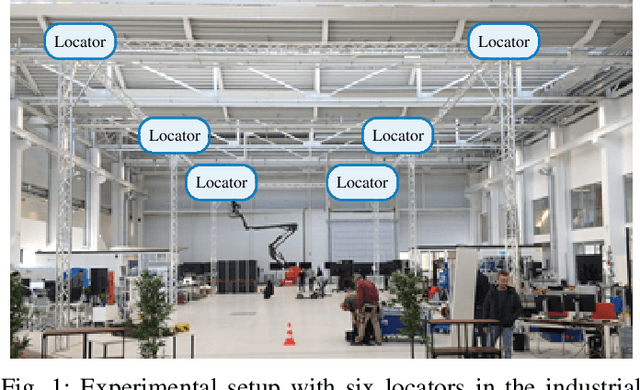
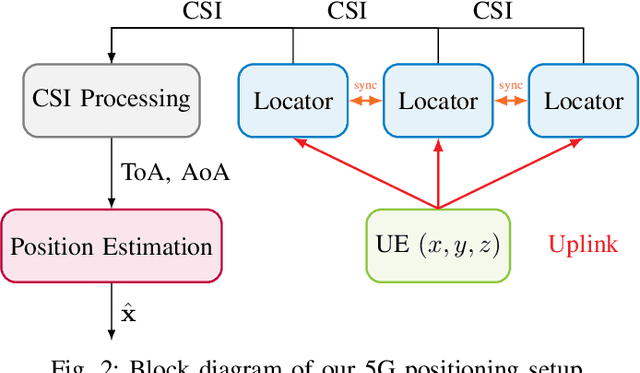
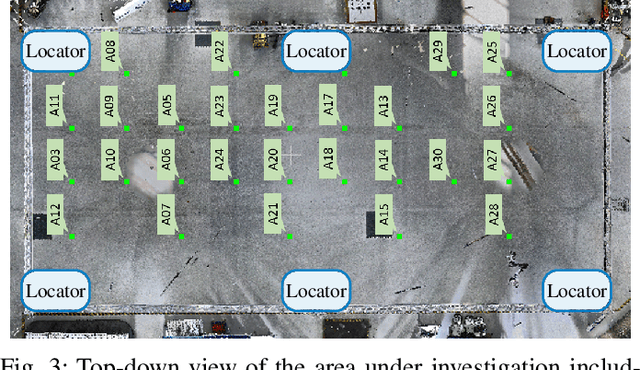
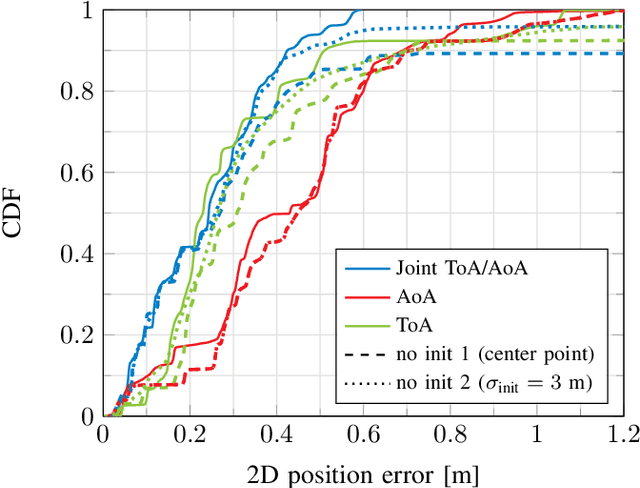
Abstract:The continuously increasing bandwidth and antenna aperture available in wireless networks laid the foundation for developing competitive positioning solutions relying on communications standards and hardware. However, poor propagation conditions such as non-line of sight (NLOS) and rich multipath still pose many challenges due to outlier measurements that significantly degrade the positioning performance. In this work, we introduce an iterative positioning method that reweights the time of arrival (ToA) and angle of arrival (AoA) measurements originating from multiple locators in order to efficiently remove outliers. In contrast to existing approaches that typically rely on a single locator to set the time reference for the time difference of arrival (TDoA) measurements corresponding to the remaining locators, and whose measurements may be unreliable, the proposed iterative approach does not rely on a reference locator only. The resulting robust position estimate is then used to initialize a computationally efficient gradient search to perform maximum likelihood position estimation. Our proposal is validated with an experimental setup at 3.75 GHz with 5G numerology in an indoor factory scenario, achieving an error of less than 50 cm in 95% of the measurements. To the best of our knowledge, this paper describes the first proof of concept for 5G-based joint ToA and AoA localization.
* Correction of small error in Eq. (1) of accepted 2022 Joint European Conference on Networks and Communications & 6G Summit (EuCNC/6G Summit) paper, which has no impact on the final results
6G Radio Requirements to Support Integrated Communication, Localization, and Sensing
May 22, 2022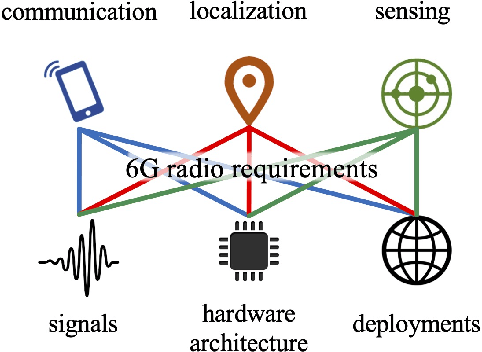
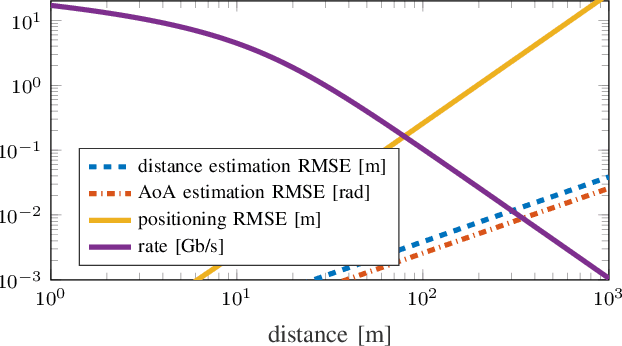
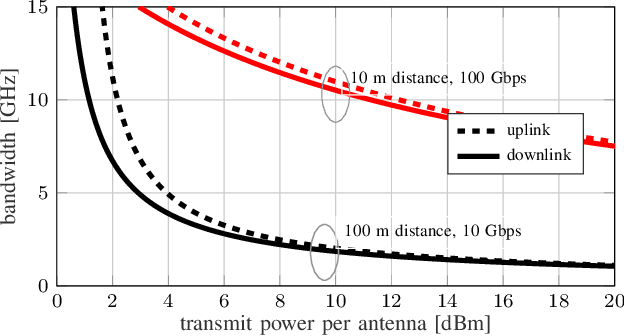
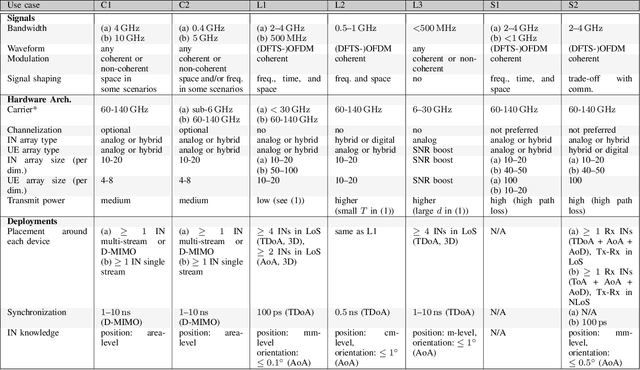
Abstract:6G will be characterized by extreme use cases, not only for communication, but also for localization, and sensing. The use cases can be directly mapped to requirements in terms of standard key performance indicators (KPIs), such as data rate, latency, or localization accuracy. The goal of this paper is to go one step further and map these standard KPIs to requirements on signals, on hardware architectures, and on deployments. Based on this, system solutions can be identified that can support several use cases simultaneously. Since there are several ways to meet the KPIs, there is no unique solution and preferable configurations will be discussed.
Unitary Checkerboard Precoded OFDM for Low-PAPR Optical Wireless Communications
Oct 06, 2021

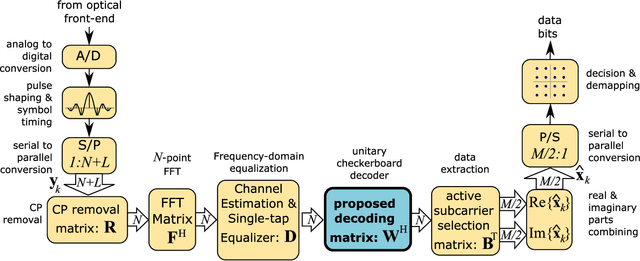

Abstract:Future 6G wireless networks will once again have to raise the capability in most of the technology domains by a factor of 10-100. Depending on the application, future requirements include peak data rates of 1Tb/s per user, 0.1ms latency, less than 1 out of a million outage, centimetre accurate positioning, near zero energy consumption at the device, and operation in different environments including factories, vehicles, and more. Optical wireless communications (OWC) have the potential to provide ultra-high data rates in a cost effective way, thanks to the vast and freely available light spectrum, and the availability of devices for transmitters and receivers. 5G NR architecture permits the integration of stand-alone OWC nodes on network layer. Current 6G research investigates advanced physical layer designs including OWC-compatible waveforms. In this context, in this paper a new pre-coded orthogonal frequency division multiplexing (OFDM) waveform is proposed that is tailored to the OWC specific needs. Its prime advantage compared to OFDM is the ultra-low peak-to-average power ratio (PAPR), while preserving other benefits, such as high spectral efficiency, flexible subcarrier nulling, and low computational complexity.
Experimental Study on Probabilistic ToA and AoA Joint Localization in Real Indoor Environments
Feb 22, 2021



Abstract:In this paper, we study probabilistic time-of-arrival (ToA) and angle-of-arrival (AoA) joint localization in real indoor environments. To mitigate the effects of multipath propagation, the joint localization algorithm incorporates into the likelihood function Gaussian mixture models (GMM) and the Von Mises-Fisher distribution to model time bias errors and angular uncertainty, respectively. We evaluate the algorithm performance using a proprietary prototype deployed in an indoor factory environment with infrastructure receivers in each of the four corners at the ceiling of a 10 meter by 20 meter section. The field test results show that our joint probabilistic localization algorithm significantly outperforms baselines using only ToA or AoA measurements and achieves 2-D sub-meter accuracy at the 90%-ile. We also numerically demonstrate that the joint localization algorithm is more robust to synchronization errors than the baseline using ToA measurements only.
 Add to Chrome
Add to Chrome Add to Firefox
Add to Firefox Add to Edge
Add to Edge